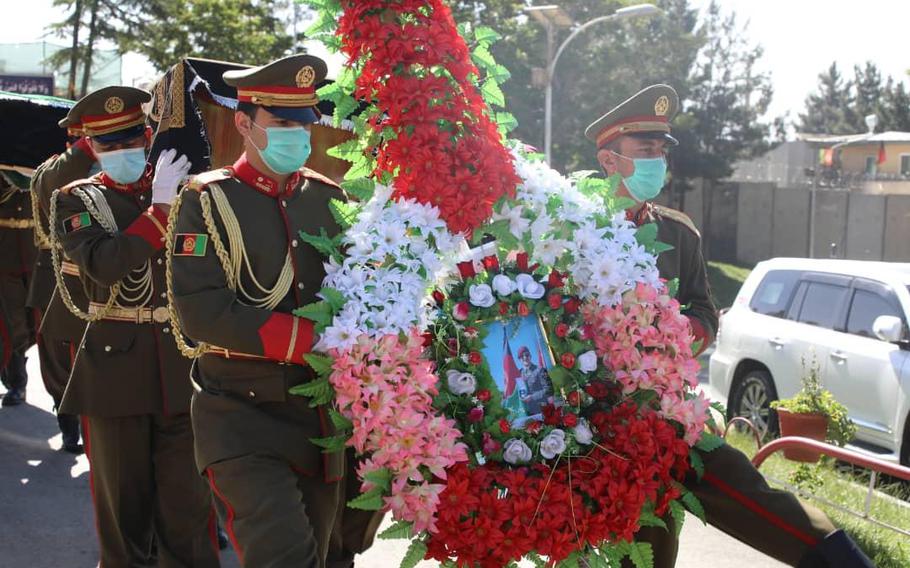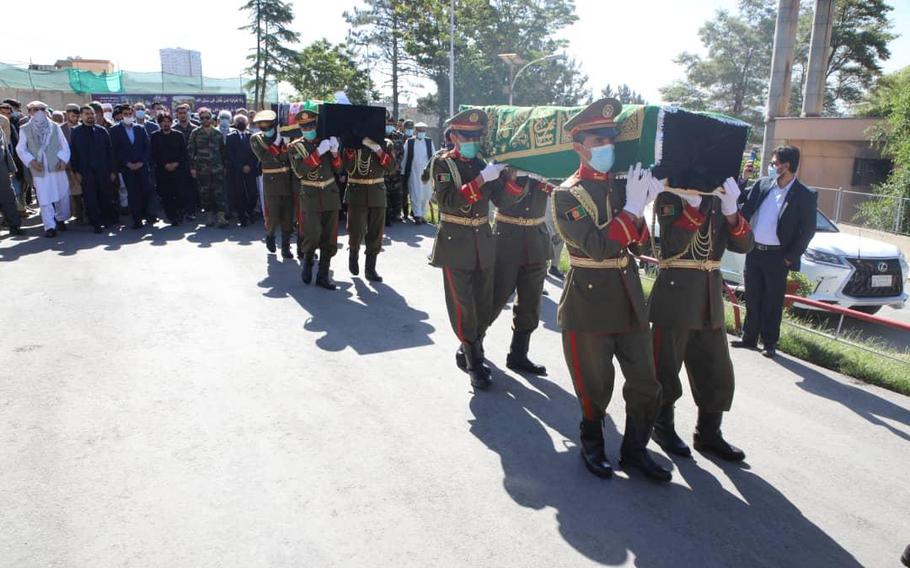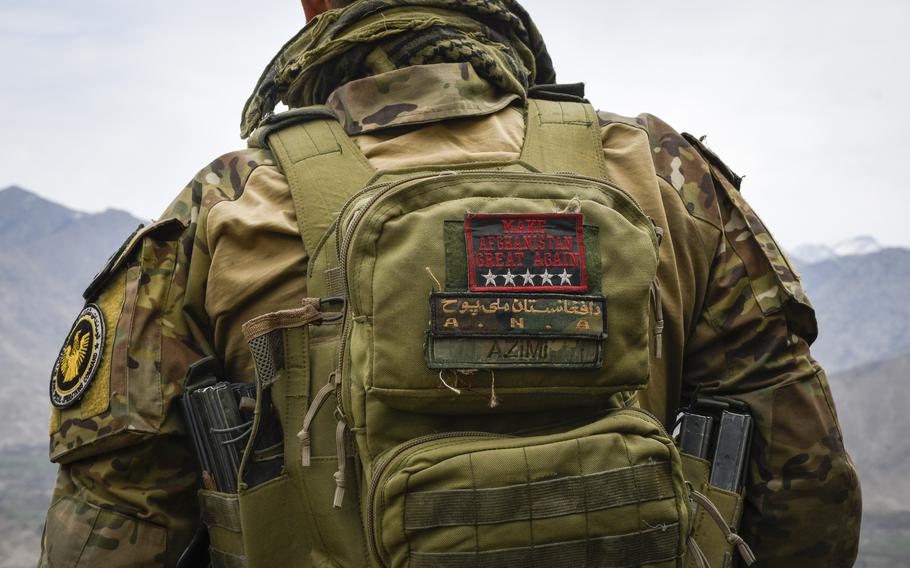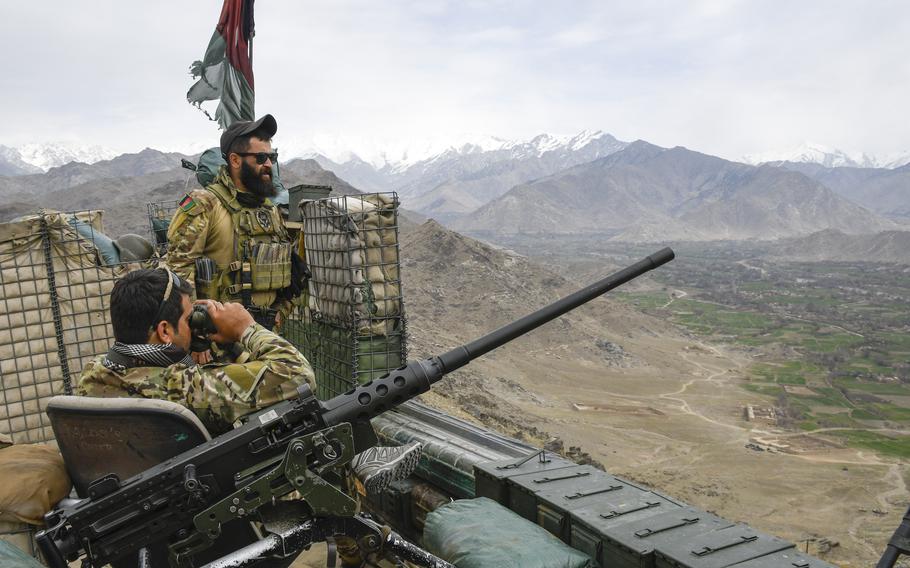As Afghanistan war nears end, details emerge on how Predator drone revolutionized warfare
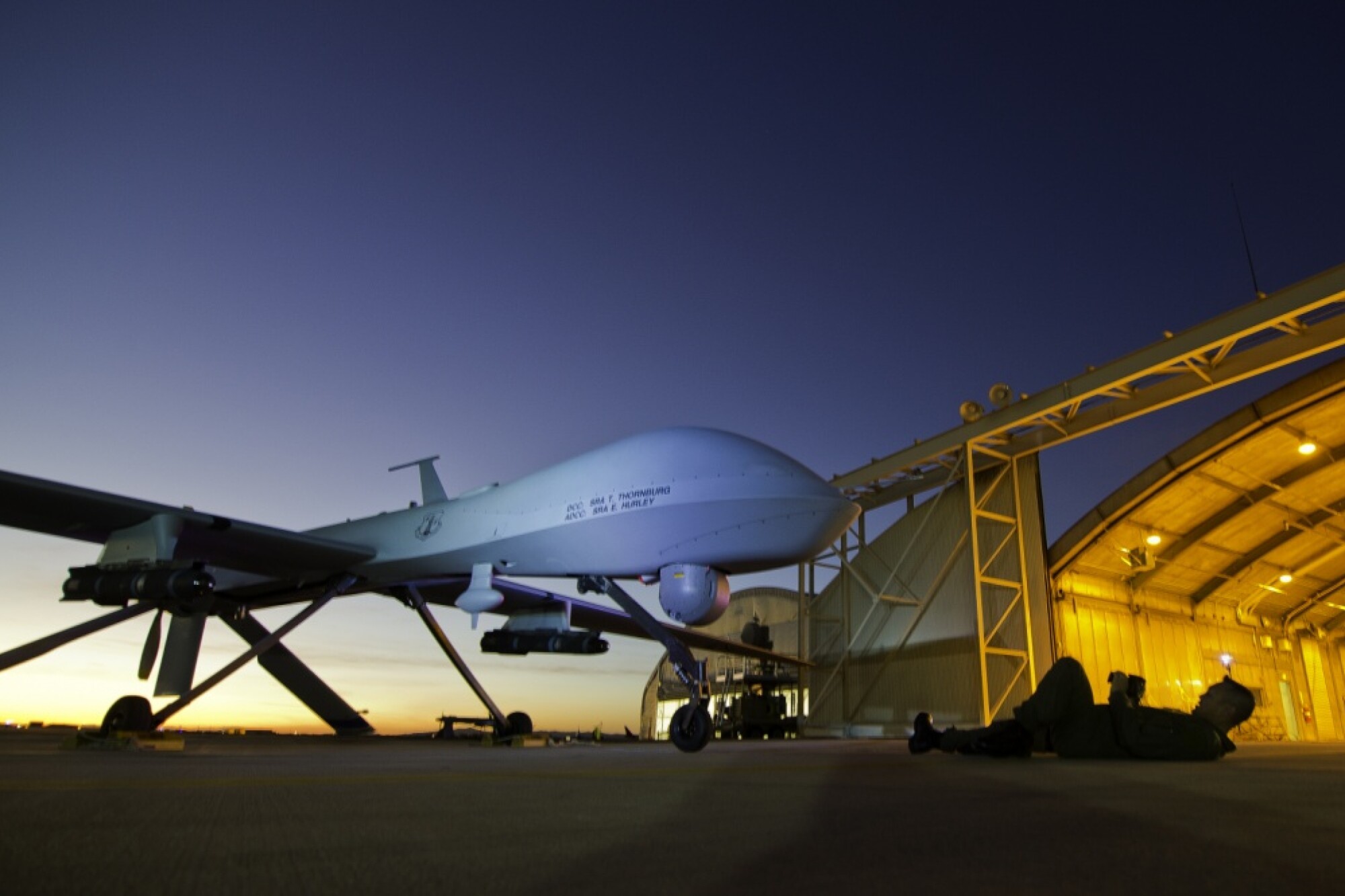
MQ-1 Predator is shown during post-flight inspection at dusk from Southern California Logistics Airport in Victorville, Calif., Jan. 7, 2012.
(US Air Force Defense Visual Information Distribution Service )
The General Atomics unmanned aircraft has been a catalyst for extraordinary growth and change in the world of unmanned aerial vehicles
JUNE 20, 2021 5:50 AM PT
“We’ve got him! Mission accomplished!”
Alec Bierbauer could hardly believe his eyes as he stood before a floor-to-ceiling TV at CIA Headquarters in Virginia, watching live video stream from an outpost in Afghanistan. He was transfixed by footage of a tall man in a white robe.
A fragile, camera-toting surveillance drone built by San Diego’s General Atomics was stalking Osama bin Laden as it quietly looped over his compound near Kandahar on Sept. 28, 2000.
The remotely-operated drone had a fearsome name — Predator — and it had unexpectedly found the terrorist leader during an experimental flight whose historic importance wouldn’t be fully realized in the moment.
The elation was quickly erased by exasperation.
The Predator had yet to be equipped with missiles. And it was unclear whether the U.S. had the legal authority to kill him. The al-Qaeda leader got away, and a year later the terrorist group attacked the World Trade Center and other targets in the United States, killing nearly 3,000 people.
The 9/11 attack triggered the war in Afghanistan, where upwards of 2,400 American troops have died, including at least 191 service members from San Diego County.
But as the war nears its 20th anniversary in October — and the Biden administration works to pull out all U.S. troops as early as next month — it is clear that Bierbauer was right to marvel at what he’d seen years earlier, and to shake his head at the naysayers who said that drones would never amount to much.
In a defining moment, a slow, propeller-driven plane that resembles an upside-down ice cream scoop showed with great clarity that it could quietly loiter high in the sky, find and monitor people, share full-motion video with allies around the world, and set the stage for precision attacks.
Or to use a less polite term, targeted killings.

A Predator drone flies over Kandahar Air Field in southern Afghanistan on a moon-lit night in 2010.
(Kirsty Wigglesworth/AP)
And, it could do so from afar. The Predator team that found bin Laden involved CIA, Air Force and General Atomics operators who weren’t directly in harm’s way.
The mission was secret, so only a handful of people knew this. But the scope of the drone’s abilities wouldn’t remain unknown, especially after the war started. A Predator later made it possible for a Marine jet fighter to kill Mohammed Atef, the military chief of al-Qaeda. It was part of a larger, successful effort to strike al-Qaeda and the Taliban.
Few people better understand how this all unfolded than Bierbauer and retired Air Force Col. Mark Cooter, who helped carry out some of the Predator’s first missions in Afghanistan, with the aid of General Atomics.
They provide an insider’s account in their expansive new book, “Never Mind: We’ll Do It Ourselves: The Inside Story of How a Team of Renegades Broke Rules, Shattered Barriers, and Launched A Drone Warfare Revolution.”
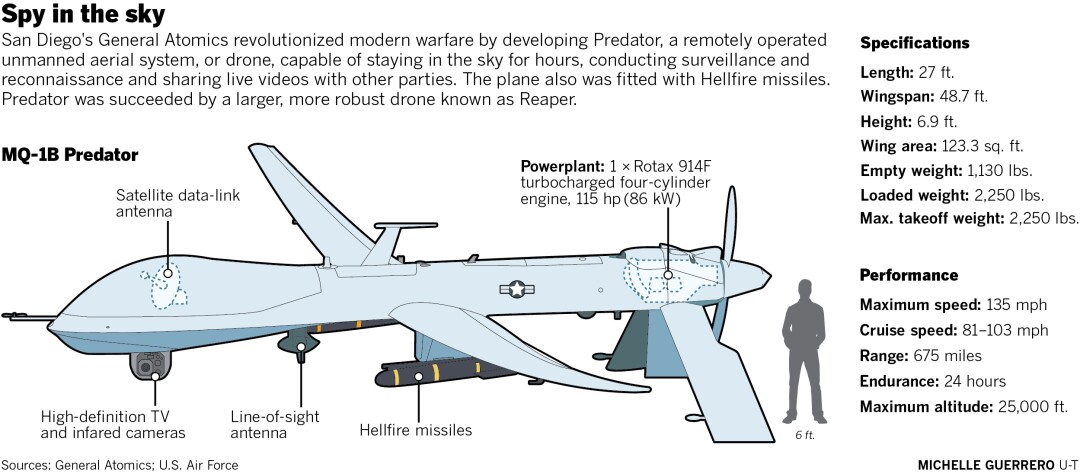
Calling it a revolution isn’t mere hyperbole. The Predator has been a catalyst for extraordinary growth and change in the world of unmanned aerial vehicles, or UAVs.
The U.S. Department of Defense now operates thousands of drones across all of its major services, using them for everything from training operators to conducting surveillance, reconnaissance and intelligence gathering, which can lead to airstrikes and other forms of attack.
The drones range from the new 1.16-ounce Black Hornet, a palm-size vehicle that can carry supplies, to the well-established RQ-4 Global Hawk, a nearly 48-foot long high-altitude, long-duration surveillance aircraft developed by San Diego’s Northrop Grumman division.
Drones are especially popular with the Air Force, which has been expanding its drone program so fast it doesn’t have enough pilots to operate them all, according to a 2020 report by the Government Accountability Office.
The Navy also broadly uses drones, including flying them off its speedy littoral combat ships to perform reconnaissance. It’s also developing unmanned “ghost” ships, some of which operate at the surface and others, like the new Echo Voyager mini-sub, that move below it.
Death from above
Adding missiles to the Predator and its larger, more capable successor, Reaper, engendered fierce criticism and raised questions about the morality of death by remote control. They became widely used in the Middle East, where air strikes have killed many civilians, defense analysts say.
Those ethical questions become even more tangled as the command-and-control concept behind the early Predator — with a “pilot” calling the shots from afar — moves toward more autonomous operations involving artificial intelligence, which could eventually make decisions without human input.
The issue worries Bierbauer, who told the Union-Tribune that the decision to use weapons “is a weighty and hard thought matter that needs to keep humans in the process.”
There are more drones to come, and soon.
Boeing is testing Loyal Wingman, a drone that is meant to shadow and shield a manned fighter aircraft. And design work is beginning on LongShot, an air-launched drone that will be packed with weapons. General Atomics and Northrop Grumman are among the early contractors.
Drones also have seeped into everyday life in a big way, especially in San Diego County, a historic leader in “fly tech.”
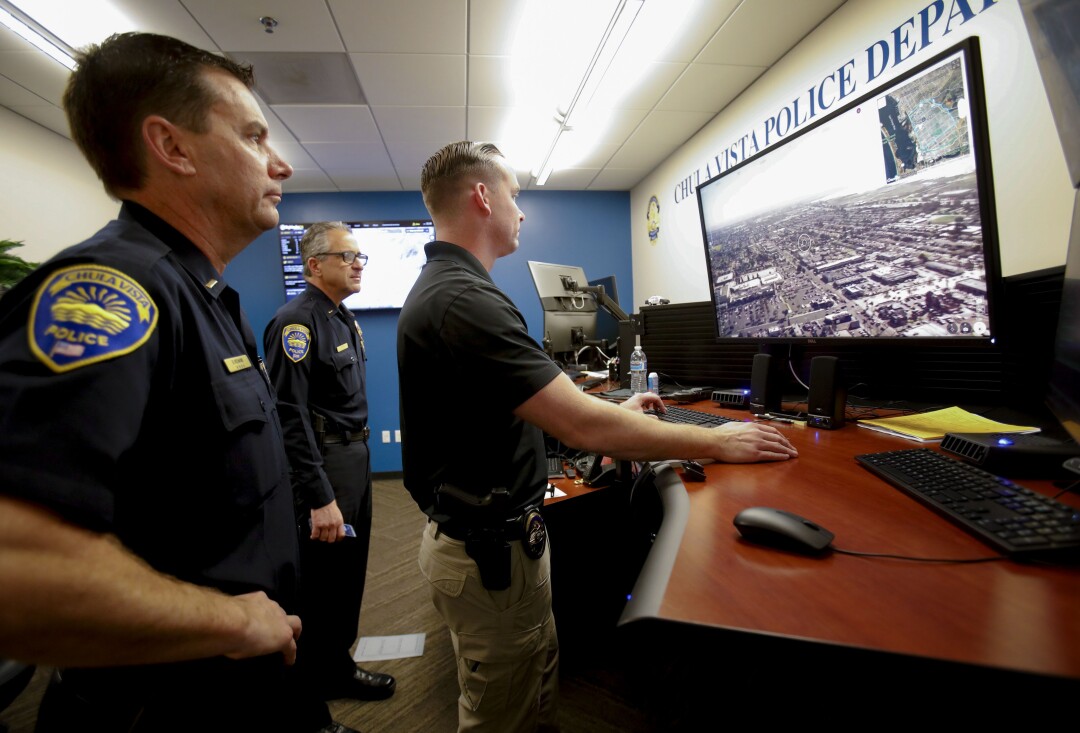
Chula Vista Police Department officers use a drone to investigate a report of a domestic violence in the parking lot of a retailer.
(Nelvin C. Cepeda/The San Diego Union-Tribune)
The Chula Vista Police Department dispatches drones on 911 calls to help size up problems. San Diego Gas & Electric uses them to inspect its power lines, as does Caltrans with bridges. U.S. Customs and Border Protection also has been using drones for surveillance along the U.S.-Mexico border.
The Predator “changed the way we wage war, altered the military, altered the CIA, reshaped the defense and aviation industries and is spreading in the civilian world faster than the Federal Aviation Administration can govern it,” renowned British historian Richard Whittle told CNET in 2014.
With another 20 years of technical advances, drone operators could largely replace human pilots in broad swaths of aviation.
“Some day soon we will have remote-operated passenger planes, air-taxis, even more automated farms, swarms of planes for fire fighting,” said Henrik Christensen, director of the Contextual Robotics Institute at UC San Diego.

A U.S. Air Force pilot and a sensor operator prepare to launch a MQ-1B Predator from a ground control station at a secret air base in the Persian Gulf region in 2016. The U.S. military and coalition forces used the base to launch drone airstrikes against ISIL in Iraq and Syria.
(Getty Images)
‘Persistent stare’
Cooter and Bierbauer’s book, which underwent a national security review that took more than three years, is part war story, part political thriller, and part tutorial on military drones, a technology little understood by the public.
Both men were mid-level insiders in an effort by the U.S. in 2000 to quickly transform General Atomics’ modest Predator drone into a robust spy-in-the-sky that could gather “actionable intelligence” against bin Laden and al-Qaeda, the source of escalating attacks against American interests.
At the time, Cooter was an Air Force officer and intelligence expert who had experience flying Predator. Bierbauer was an intelligence operations officer for the CIA. They came from different cultures but were both pro-drone, partly because there was little alternative.
As many authors have noted, the U.S. wasn’t willing to place large numbers of troops in Afghanistan in 2000. Satellites were helpful but couldn’t linger overhead. Nor could high-altitude reconnaissance planes. And it was hard to cultivate a ground network of informants. Most of Afghanistan was controlled by the Taliban, which had given al-Qaeda safe haven. The U.S. did pick up some information about bin Laden’s movements, but it wasn’t timely enough to act on.
The solution seemed to be remotely-operated drones, a fairly primitive technology that had been developed in fits and starts over decades. But drones had cameras that could fix on people and places for hours. The military calls it “persistent stare.”
The CIA and Defense Department wanted to move things forward. To do that, they turned to General Atomics, whose owners, brothers Neal and Linden Blue,were working on drones in Poway, at the company’s aeronautical systems division. And they loved to push the envelope.
General Atomics workers experienced a “can they be serious?” moment in 1986, shortly after the brothers purchased the company, which had long focused on the peaceful use of atomic energy.
Neal floated the idea of having General Atomics develop drones that could be sent on kamikaze missions against Nicaragua’s gasoline infrastructure. This appears to have been tied to long-term political issues he had with the Central American country’s leadership.
The enterprise was given a name — Predator — and quickly fizzled. But the Blues’ interest in drones was real, and they had a lot of credibility when it came to aviation.
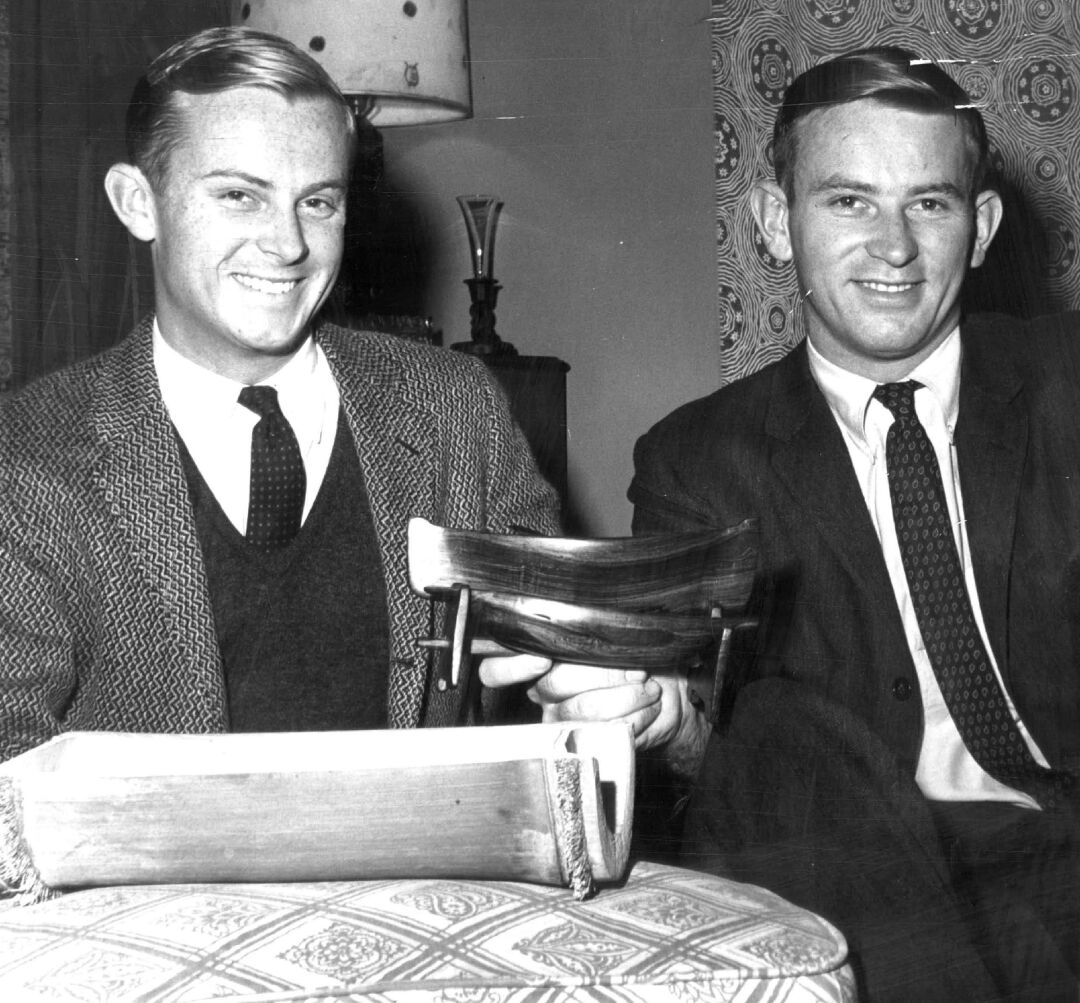
Neal, left, and Linden Blue in 1961.
(Denver Post/Denver Post via Getty Images)
The rich, Yale-educated siblings learned to fly when they were young and indulged their wanderlust. In the 1950s, they squeezed into a tiny plane and explored South America on a perilous 22,000-mile journey that was featured on the cover of Life magazine with the headline, “The Flying Blue Brothers.”
More adventure followed for Linden. In 1961, a Cuban jet fighter forced him to land on the Caribbean island apparently due to a misunderstanding about whether he had permission to be in the area.
He was jailed for 12 days then expelled from the country, shortly before chaos struck. A group of CIA-trained Cuban refugees made a failed attempt to topple President Fidel Castro during the infamous the Bay of Pigs invasion.
The brothers went on to serve in the Air Force, where Linden joined the Strategic Air Command at an important moment: it was developing cutting-edge reconnaissance aircraft to use against the Soviets.
The Blues turned out to be savvy observers when it came to talent, technology and opportunity.
In the early 1990s, they bought the assets of Leading Systems, an Irvine-based company which had been developing a line of small, reliable, affordable drones. The company was run by Abe Karem, a revered aeronautical engineer who had few peers when it came to building unmanned aircraft.
Karem believed he was on the verge of selling lots of drones to the U.S. military. But interest waned. With their strong pilot cultures, the Air Force and Navy were built around the idea of putting people in cockpits, not taking them out. Karem ended up going bankrupt. Neal and Linden ended up with his airframes, which evolved into today’s Predator.
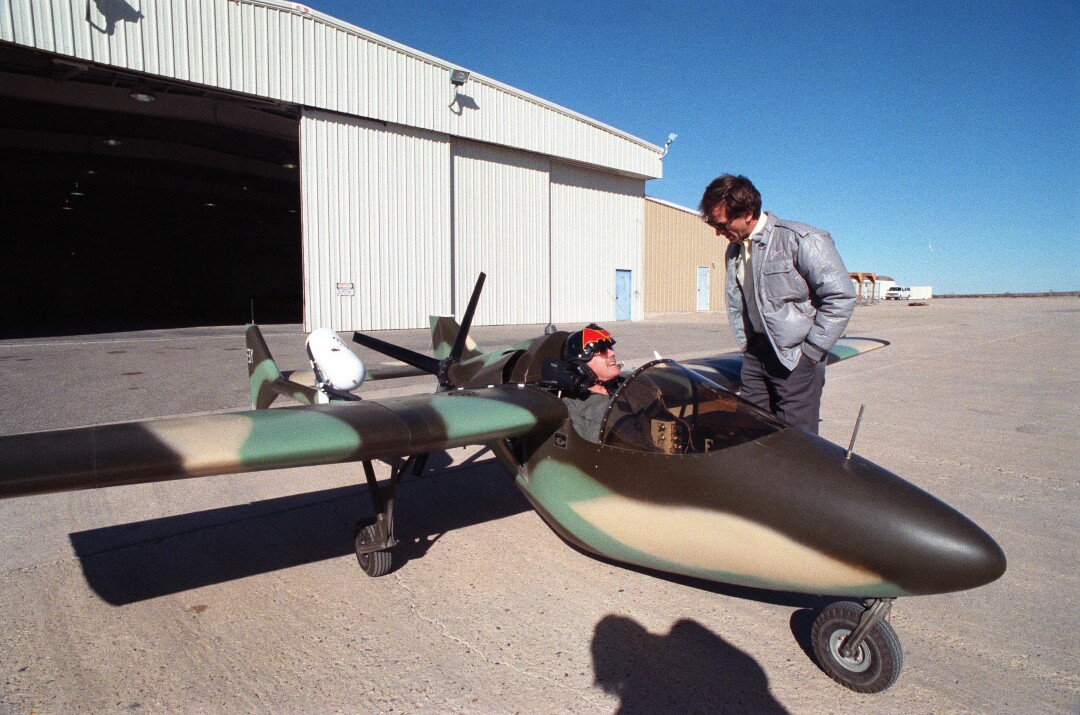
Linden Blue, co-founder of General Atomics, right, talks with Bill Sadler of Sadler Aircraft, who is in one of his light aircraft in 1988.
A dubious spy
In early 2000, President Bill Clinton was upset by the lack of progress the U.S. was making in tracking down bin Laden, who had been involved in the bombing of two U.S. embassies in East Africa in 1998. The attacks killed more than 200 people.
Clinton basically gave the CIA and Pentagon nine months to solve the problem. And they decided that upgrading the Predator had to be part of the solution.
It was a daunting task.
The Predator had been used in Bosnia and Kosovo. But “according to conventional wisdom, one would have been hard pressed to imagine a contraption less suited for the modern battlefield,” Cooter and Bierbauer say in their book.
Cooter told the Union-Tribune the plane “only had a max speed of about 120 knots, it normally flew at about 70 knots. It didn’t have any self-protection, like a receiver that would have warned if it had been picked up on radar. And it couldn’t talk to other planes.”
Predator also didn’t have a big history of doing time-sensitive surveillance, which would be required for missions into Afghanistan. A large team of analysts was needed to evaluate data quickly and determine where the drone should go and what it should do.
“Afghanistan is huge. You can’t just aimlessly fly around,” Bierbauer said.
The U.S. also could not launch and land Predator from inside Afghanistan. It would have to create a forward operating base in a neighboring country to avoid detection, reprisals and political turmoil.
Solutions fell into place, including one that enabled the drone’s operators to eavesdrop on Taliban air defenses.
But it was a tense time. There was so much concern that the forward operating base in Uzbekistan would be discovered that a decision was made to fly the drone only at night. Trouble quickly followed.
In late summer, on the first test flight, the Predator crashed and was destroyed. The drone’s operators didn’t have access to all of the data they would have during a daytime flight, leading to an operational error.
Successful science project
The team had a second Predator, which began secret surveillance flights on Sept. 7. Three weeks later, the drone discovered a man believed to be bin Laden outside Kandahar, during Friday prayers.
“I think everybody’s collective reaction was we got him, this is it,” Bierbauer told the Union-Tribune. “It was probably 20, 30 seconds of just jaw-hanging disbelief and then, ‘Now what?’”
The U.S. had the ability to launch an airstrike from submarines in the Indian Ocean. And that appeared to be the plan. But it didn’t happen.
There were legal questions about whether the U.S. had the right to essentially assassinate bin Laden, analysts say. There also was concern about the blowback that would occur if such an airstrike went awry in any way.

A Predator drone, armed with a missile, sits on the tarmac of Kandahar military airport.
(MASSOUD HOSSAINI/AFP/Getty Images)
Cooter says he isn’t sure who made the final decision in the matter, but he’s unhappy about how things turned out.
“It’s like you’re on a football team and you draw up a play and you know your responsibility, but the play doesn’t work because someone doesn’t do what you thought they were going to do,” he said.
But he also draws positives from that moment, adding, “The team put eyes on bin Laden and brought the Predator home safely. We did what we were supposed to do. We went from humble beginnings to where we are now with unmanned aerial vehicles in the U.S. arsenal.”
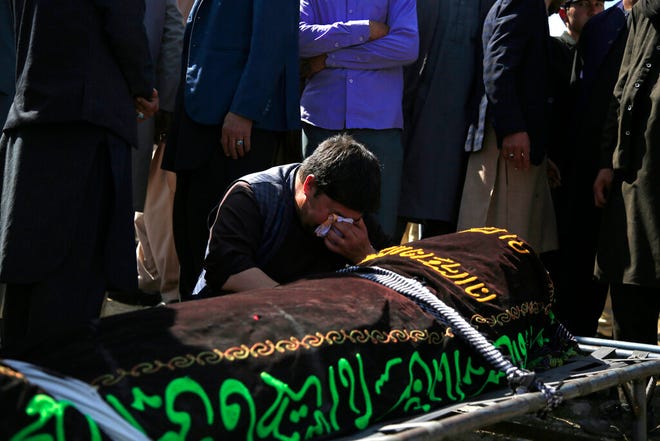
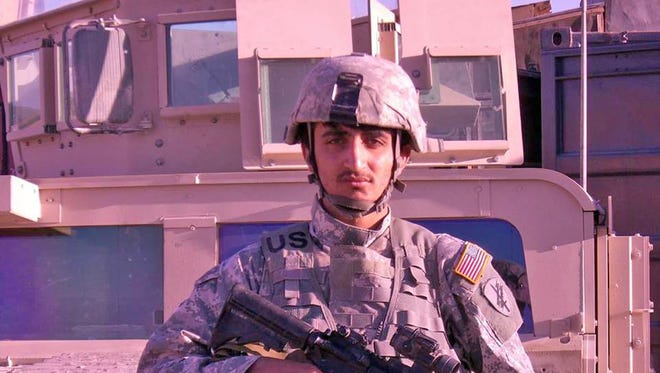

:quality(70)/cloudfront-us-east-1.images.arcpublishing.com/mco/ZGB5TUYZXNAX5B25NR5JBVI5K4.jpg)









